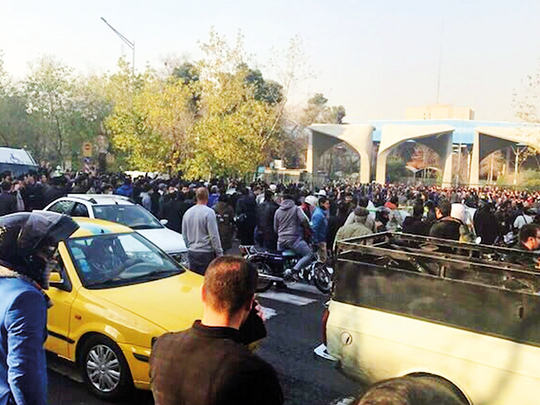
Dubai: Protests have raged for the past few days in several major Iranian cities, and these will grow if the government ignores peoples’ demands for economic and social reforms, Iran experts said.
However, they explained it is premature to predict the direction public anger in Iran will take. These riots are the first of their kind since the unrest that followed the 2009 presidential election. “For 38 years, the Iranian people have been living under pressure, suffering from tyranny and corruption,” said UK-based Ali Nour Zada, director of the Iranian-Arab Studies Centre. The protests started in the north-eastern city of Mashhad on Thursday, and spread to other cities.
“People saw their demands ignored by the government, while their country was involved in foreign [conflicts] and public money was wasted in other countries, like Syria and Yemen. All this [is happening] and the Iranian citizen witnesses the deterioration in his standard of living,” said Zada in an interview to Gulf News.
“President [Hassan] Rouhani promised to improve the living conditions of the Iranian people. Few changes happened; the inflation continues to grow,” Zada, an Iranian-Briton, said.
Other researchers on Iran affairs agreed.
“The living conditions in Iran are declining continuously and the regime used to blame it on the international sanctions,” said Ahmad Kamel Bouheiri, an analyst at the Cairo-based Al Ahram Strategic Studies Centre.
“However, this excuse [ended] in 2015, when the economic sanctions were lifted,” Bouheiri told Gulf News.
Iran, a key Opec member and a country with the fourth largest oil reserves in the world, was hit with international sanctions because of its controversial nuclear programme. But after reaching an agreement with the Big Powers in July 2015, sanctions were lifted, and Tehran re-entered the international market in January 2016. It is estimated that the sanctions cost Iran more than $160 billion (Dh588 billion) in oil revenue since 2012
The nuclear agreement and the subsequent easing of economic boycott offered Tehran an immediate access to more than $50 billion in frozen assets and the freedom to sell oil and purchase goods on the international markets.
Yet, analysts said, the internal economic situation was not reformed, and Iran continued with its financial and military support to some armed groups in Arab countries, like Hezbollah in Lebanon, Hamas in Gaza, and Al Houthis in Yemen.
According to press reports, some protesters chanted in Mashhad, “Not Gaza, not Lebanon, my life for Iran”, in reference to Tehran’s support for foreign groups.
The protests are seen as the biggest show of defiance against the regime since 2009, when pro-reform rallies were organised to protest the outcome of the presidential elections that year, in which conservative candidate Mahmoud Ahmadinejad was declared the winner.
During the present protests, people chanted political slogans against the supreme leader of Iran, Ayatollah Ali Khamenei. So far, six protesters have been killed. Iranian officials blamed the first two killings on foreign agents and not the police, while Iran’s Revolutionary Guards have warned anti-government protesters that they will face an “iron fist” if the unrest continues.
“People are tired of having a theocratic regime,” said Zada. “The whole regime is targeted and [people are saying] no to Islamists and fundamentalists.”
Photos circulated on social media of an Iranian woman protesting in public without a headscarf, holding the hijab on a stick.
Iranians are comparing their way of living before and after the 1979 revolution, and some have “fond memories” of the days of the Shah, said Zada.
“Before the revolution, Iran was an advanced country in terms of social life. In politics, there were limits and constraints, but socially, there was an advanced cultural life and there was equality between men and women,” said Zada.
“Iranian women are looking at Saudi women and see them [being] allowed to attend festivals and concerts, while they are not,” he said in reference to the freedoms given to Saudi women recently as part of social reforms in the conservative kingdom.
Responding to a question on how far the protests can go, Zada said, “This time is much more than the green revolution [2009 protests in Tehran]. We are talking about a total public rebellion. But we are still at the beginning. The picture will be clearer in the next few days.”
However, Bouheiri said much will depend on how the Iranian regime responds.
“Will the regime reciprocate and introduce economic reforms and fight corruption, or will it use tools of oppression like in 2009?” asked Bouheiri.
The difference between this time and 2009 is that this time, protests are not related to elections, but rather to a more comprehensive crisis that has both political and economic aspects, explained analysts.
Meanwhile, the president of the National Iranian American Council Trita Parsi issued a statement in Washington and renewed calls for “the Iranian government to uphold its international human rights obligations, including allowing the right to free expression, to respect the dignity and safety of every Iranian and to refrain from violence.”
Parsi added that it is up to the “Iranians living in Iran to decide their country’s destiny”.











